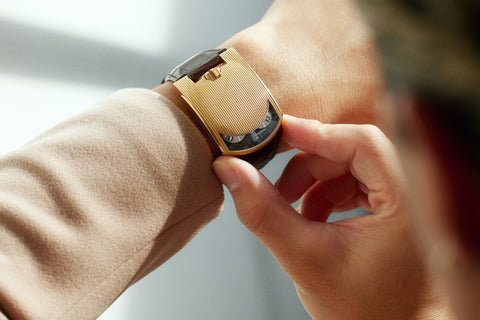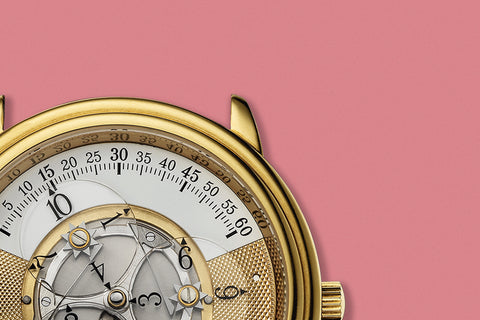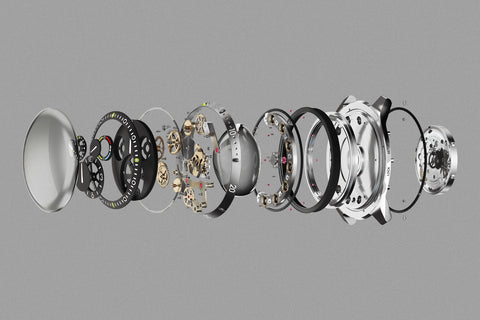Over the years, Urwerk has built its reputation on innovation in time telling, often leaning on historic references and reinterpreting them. Whether it is the wandering hours of the original UR-101 – which was inspired by a 17th century night clock created by the Rome-based Campani watchmaking brothers for Pope Alexander VII – or indeed the UR-CC1, which was a successful execution of a linear time display which Patek Philippe first ventured – the brand’s work has always been historically minded, yet innovative.
In this vein, the brand introduced the UR-210 in 2012, the first watch to layer a retrograde minutes indicator on top of the wandering hours the brand had built its identity on. The UR-210S came in 2015 and was produced in a series of 35 pieces, with a stainless-steel case and a matching bracelet crafted by specialist maker Maspoli. This particular piece was the very first one of this series.
It features a complex stainless-steel case, measuring 43.8mm across, 53.6mm long and 17.8mm tall. However, the dimensions only tell half the story, given the complex form of the case. The monocoque form has an integrated bezel that recesses in some parts while matching the form of the midcase in others. The bezel wears circular satination, with the recessed parts revealing media blasting.
The ’bezel’ has bevelled edges, with this kind of finishing more pronounced on the arc along the southern portion of the case. The bezel has an overhang, with the recessed midcase integrating the lower lug. The a cleft runs almost the length of the midcase. Such varying textures and undulating aspects are deftly employed to bend the perception of the watch's proportions on the wrist.
The oversized, crown is partially integrated into the top of the case, is protected by a bar that is screwed on to the top lug. This lug is angled with ergonomics in mind. The UR-210S comes on a specially designed bracelet by maker Maspoli. The satinated, narrow, flat links articulate around the wrist providing a comfortable wearing experience. The bracelet is secured by a double deployant clasp.
The sapphire crystal – while hemmed by a black bezel – sits flush, its curvature following the trajectory of the case. The hours are etched on three rotating cubes that are vertically brushed. The arrangement makes extensive use of titanium. Their sequential switching is guided by a cam. Every hour, one of the cubes coincides with the aperture of the retrograde minutes arm milled from aluminium to keep the arrangement lightweight.
The arm is mounted on a central axis with ruby bearings and a substantial tension spring around this axis. The second arm’s position is based on a star-shaped cam – when it reaches the end of the hour, the cam causes the spring to reset the seconds arm back to the 0 position precisely with a reassuring and audible mechanical ‘clunk’. The minutes hand, which features a red arrow tip, corresponds to a printed 120º arc graduated into 60 minutes. Following this is a satinated rim with an applied quarter chapter of Arabic minutes.
The mechanics of the wandering hours and the retrograde minutes lie low within the display, the ARCAP P40 baseplate underneath it decorated with perlage. It features a power reserve indicator to the right corner that counts down the 39 hours of reserve, while to the left lies a winding efficiency indicator. On a red and green +/- scale it shows the mathematical difference between the energy expended by the mainspring and the energy it gained by way of the winding rotor – which is linked to the wearer’s activity – over the previous two hours. If the indicator is in the red, the wearer can compensate for this by being more active. This is a first in watchmaking and the technology underpinning it is proprietary to Urwerk.
On the caseback, crafted from non-allergenic titanium in a clous de Paris style, lies a window into the self-winding calibre UR-7.10. Displayed here is the proprietary turbine system Urwerk employs to manage the spinning of the winding rotor in the non-winding direction. The aim is to protect wear on the bearings that secure this part. The wearer can manipulate the action of the turbine and, through it, that of the winding rotor – a fluted dial integrated into the caseback can be set to ‘full’, ‘reduced’ or ‘stop’ positions. The first position allows the winding rotor to spin freely and is designed for sedentary periods. The reduced position is ideal for light activity while in the stop position the calibre UR-7.10 essentially functions as a manually wound movement. It is suited to high intensity activity.
The UR-7.10 beats at 28,800 vibrations per hour and features a single mainspring barrel. It features 51 jewels. This UR-210S comes with its full set of outer and inner boxes as well as warranty and instruction paperwork.
In its full metal jacket guise, the UR-210S is one of a handful of references from Urwerk to come furnished with a bespoke bracelet. The stainless-steel case and bracelet offers a sporty combination produced in very limited numbers.
If sold within the United Kingdom, this Urwerk UR-210S will be subject to 20% VAT



















































































































































































































